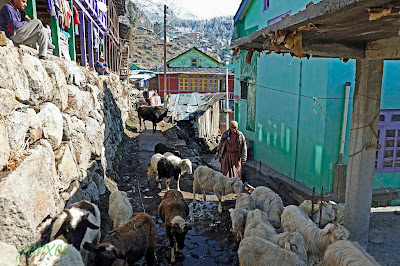 |
Under the Railway
There are various ways to do the walk, we did it supported by an organiser, Thistle Trekking who did everything but hike for
us. They were flawless in that they booked accommodation and moved heavy baggage ahead, provided guides and took care of all the logistics. So all we had to do was walk with a daypack. The other
extreme way of doing the Way is camping in designated areas and completely self-supported. Along the
trail we saw many campers carrying massive loads and waltzing along, setting up
at the many beautiful campsites along the Way.
|
 |
An interesting section of Trail
Details of equipment required and suggested itineraries have
been described in various blogs and articles on the net. So I will only
emphasise what I feel is important, nay, vital for an enjoyable walk. If it interests you read my earlier blog on appropriate gear titled The Fashionate Trekker. The military roads are broad and well
defined, but uneven and roughly cobbled stone and inappropriate
footwear can result in very painful soles and blisters. Comfortable walking/hiking boots well broken
in and water-resistant, (emphatically do not wear athletic or soft soled
running shoes) and appropriate socks,
will make for happy feet, and happy feet are essential for this walk.
Good rain gear and comfortable daypack come next. The midges in summer can
drive you crazy, literally, so a headnet and/or repellent is a must.
|
 |
| ...The vast flat emptiness of Rannoch Moor Said to be one of the largest Moors in these parts, it follows a long glen between the highlands. It is very wet and boggy, making it very inhospitable and precluding any habitation. I carried a camera to supplement the snapshots I took on my mobile when it was wet. When trekking with a camera I always make sure I have a comfortable means of carry, this time a cross shoulder strap that I had made myself; waterproof cover, and I mean "water proof" as water can quickly kill a camera. I had a spare battery and memory card and just one lens, a Fuji 18-55mm kit lens. Simply remember, each additional gram on a long trek is going to seem like a kilo. For a more detailed blog on trekking with a camera see my earlier blog The Trekking Photographer |














































